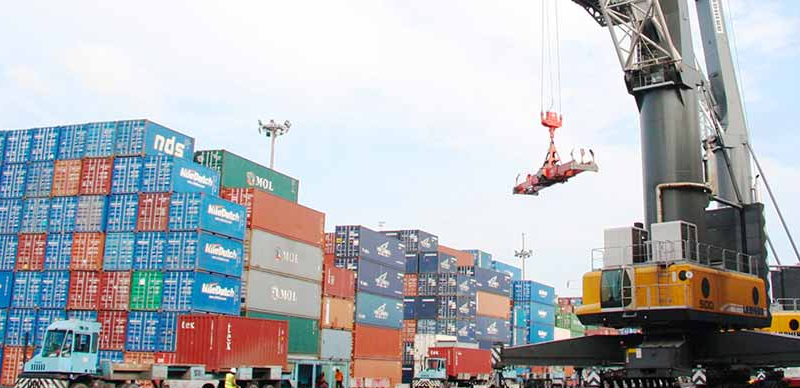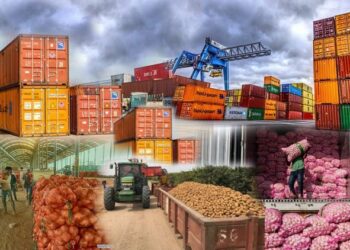High exchange rates occasioned by the devaluation of naira by the administration of President Bola Tinubu and inflation have increased the cost of clearing cargo containers and vehicles at the nation’s seaports up to between 400 per cent and 500 per cent in five years.
NATIONAL ECONOMY gathered that the exchange rate, especially the United States dollar moved from N410/$ in 2020 to N1,498/$1 in February 2025.
Also, according to the National Bureau of Statistics (NBS), the inflation rate in Nigeria also rose from 12.20 per cent in February 2020 to 34.48 per cent in December 2024, thereby, exerberaing cost of goods and services in the country.
This means the exchange rate has increased by 265.4 per cent in the last five years.
The increase in exchange rate has, however, led to increased cost of cargo clearance and added to Port Cost.
For instance, the cost of clearing a 2005 Toyota Corolla moved from N450,000 in December 2020 to N2,400,000 in February 2025.
Also, the cost of the 2010 Toyota Corolla moved from N650,000 to N3,000,000 in the same year under review.
The increment, according to financial analysts, was due to an increase in the exchange rate that jacked up the cost of Customs duty and other charges at the port in the last five years.
Also, according to clearing agents, payment of Customs duty on a 20ft or 40ft container consisting of general cargo has moved from N3.5 million in 2020 to N8 million and N13 million, respectively.
They argued that by adding other charges such as shipping, terminal, and demurrage charges, the importer could pay as much as N13 million to N15 million for 20ft and N20 million to N23 million for a 40ft container.
NATIONAL ECONOMY gathered that aside from Customs duty, importers pay an ECOWAS Trade Liberalisation Scheme (ETLS) fee, Financing NCS Operations (FCS) charge, a Comprehensive Import Supervision Scheme (CISS) fee and a surcharge before they can clear their cargoes out of the port
Also, other regulatory agencies that deal with controlled products, such as the Standards Organisation of Nigeria (SON), the National Agency for Food and Drug Administration and Control (NAFDAC) and the National Environmental Standards and Regulations Enforcement Agency (NESREA), among others, charge between N150,000 and N200,000.
Speaking to our correspondent, the public relations officer of the Africa Association of Professional Freight Forwarders and Logistics of Nigeria (APFFLON), Clinton Okoro, said importers pay at least a million to move a 20ft container out of the port or a million on a 40ft container.
According to him, that is a benchmark even though clearing agents have kicked against a benchmark, saying it’s not international best practice.
“In 2020, there wasn’t inflation and the exchange rate was stable. Then, we clear a 20ft container with N3.5 million to N4 million while a 40ft container goes for N8 million.”
Okoro, the chief executive officer of Globe Joy Investment Nigeria Limited, said with shipping, terminal, storage and even demurrages, a 40ft container in 2020 can exit the port for at most N13million.
“Now, that is in 2025, it’s between N13 million to clear a 20ft container consisting of general cargo and N23 million for a 40ft container of the same content.”
However, he said when the 4 per cent Free on-board (FoB) charges were introduced by the Nigeria Customs Service (NCS), Customs duty went up, but the suspension by the service further reduced clearing costs by 4 per cent.
Also speaking to NATIONAL ECONOMY, the managing director of KB NAMA Motors, Aminu Nababa, said the price of vehicle clearance rose astronomically due to the exchange rate.
According to him, in 2020, a dollar exchange for N410 in the official market and N470 in the black market but currently, the Customs exchange rate for clearance of cargo is N1,498.
He stated that with over 400 per cent increase in the exchange rate, it will affect the cost of clearance and sales of vehicles.
“In 2020, a 2005 Toyota Corolla can be cleared for N450,000 and a Toyota Camry 2010 for N650,000, but now, the clearance of the same vehicle goes for N2.4 million and millions, respectively.
“That includes Customs duty, ETLS, shipping and terminal charges as well as Demmurage if possible,” he stated.
Speaking to Journalists recently, a maritime stakeholder, Funmilayo Uche, warned that rising charges and inefficiencies are pushing importers away.
“In December, we moved a 40-foot container for N400,000 to N500,000. Today, it costs between N850,000 and N1 million. How can businesses survive?” she asked.
Uche criticised the justification for the increase saying, “They said they need funds for infrastructure, but where are the improvements? Even simple processes like obtaining loading papers are chaotic. Truckers blame terminal operators, and terminal operators claimed they’re not responsible. It is a mess,” she said.





